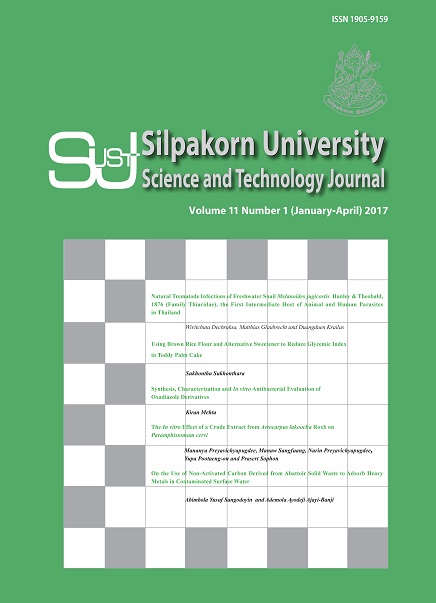The In vitro Effect of a Crude Extract from Artocarpus lakoocha Roxb on Paramphistomum cervi
Main Article Content
Abstract
The present study was carried out to evaluate the anthelminthic activity of the extract from Artocarpus lakoocha Roxb (Traditional name: “Puag-Haad” (PH)) against rumen fluke, Paramphistomum cervi. The parasites were incubated in M199 medium containing either extract of PH or albendazole (ABZ) at 250, 500, 750, 1,000, 2,000 µg/ml, for 3, 6, 12 and 24 h. The efficacy of the extracts or ABZ was assessed by using relative motility (RM) assay which was determined on the basis of comparing the loss of spontaneous movement and/or death of the trematodes between treated and control group. The trematodes were further observed under scanning electron microscopy (SEM). PH expressed the potential in killing the trematode and the maximum efficacy was exhibited at 2,000 µg/ml which was higher and had significantly different RM and SI values than ABZ (p < 0.05). Through observations by the SEM it was found that the PH also caused more damage on the tegument of P. cervi than ABZ, while the sequence of tegumental alterations was similar, i.e. comprising of swelling, blebbing, which subsequently eroded the tegumental syncytium. The severity and rapidity of the damages were directly related to concentration of the crude extract and time of incubation. The results obtained in the present SEM-based study established the anthelmintic activity of PH against P. cervi.
Downloads
Article Details
References
Bulman, G. M., Caracostantogolo, J., Lamberti, J. C., Zenon, A. A., and Balbiani, G. (2002). Cotylophoroncotylophorum (Fischoeder,1901)(Digenea:Paramphistomidae), trematode of bovine rumen, in Argentina.Vet Argent, 19: 673–682.
Charoenlarp, P., Radomyos, P., and Bunnag, D. (1989). The optimum dose of Puag-Haad in the treatment of taeniasis. Journal of the Medical Association of Thailand, 72: 71-73.
Eduardo, S. L. (1982). The taxonomy of the family Paramphistomidae (Fischoeder, 1901) with special reference to the morphology of species occurring in ruminants. I. General considerations. Systematic Parasitology, 4: 7–57.
Ehteda, A., Galettis, P., Pillai, K., and Morris, D. L. (2013). Combination of albendazole and 2-methoxyestradiol significantly improves the survival of HCT-116 tumor-bearing nude mice. BMC Cancer, 13: 86.
Halton, D. W. (2004). Microscopy and the helminth parasite. Micron, 35: 361–390.
Kanchanapoom, T., Suga, K., Kasai, R., Yamasaki, K., Kamel, M. S., and Mohamed, M. H. (2002). Stilbene and 2-arylbenzofuran glucosides from the rhizomes of Schoenocaulon officinale. Chemical & Pharmaceutical Bulletin, 50: 863-865.
Kiuchi, F., Miyashita, N., Tsuda, Y., Kondo, K., and Yoshimura, H. (1987). Studies on crude drugs effective on visceral larva migrans. I. Identification of larvicidal principles in betel nuts. Chemical & Pharmaceutical Bulletin, 35: 2880-2886.
Likhitwitayawuid, K., Sornsute, A., Sritularak, B., and Ploypradith, P. (2006). Chemical transformations of oxyresveratrol (trans-2, 4, 3′, 5′-tetrahydroxystilbene) into a potent tyrosinase inhibitor and a strong cytotoxic agent. Bioorganic & Medicinal Chemistry Letters, 16: 5650-5653.
Maneechai, S., Likhitwitayawuid, K., Sritularak, B., Palanuvej, C., Ruangrungsi, N., and Sirisa-ard, P. (2009). Quantitative Analysis of Oxyresveratrol Content in Artocarpus lakoocha and ‘Puag- Haad’ . Medical Principles and Practice, 18: 223-227.
Mongolsuk, S., Robertson, A., and Towers, R. (1957). 2, 4, 3’,5’-Tetrahydroxystilbene from Artocarpus lakoocha. Journal of the Chemical Society, 2231–2233.
Newman, D. J., and Cragg, G. M. (2007). Natural products as sources of new drugs over the last 25 years. Journal of Natural Products, 70: 461-477.
Newman, D. J., Cragg, G. M., and Snader, K. M. (2003). Natural products as sources of new drugs over the period 1981-2002. Journal of Natural Products, 66: 1022-1037.
Panyarachun, B., Sobhon, P., Tinikul, Y., Chotwiwatthanakun, C., Anupunpisit, V., and Anuracpreeda, P. (2010). Paramphistomum cervi: surface topography of the tegument of adult fluke. Experimental Parasitology, 125: 95-99.
Prasitirat, P., Chompoochan, T., Nithiuthai, S., Wongkasemjit, S., Punmamoamg, T., Pongrut, P., Chinone, S., and Itagaki, H. (1997). Prevalence of amphistomes of cattle in Thailand. Parasitology, 29: 27-32.
Preyavichyapugdee, N., Sangfuang, M., Chaiyapum, S., Sriburin, S., Pootaeng-on, Y., Chusongsang, P., Jiraungkoorskul, W., Preyavichyapugdee, M., and Sobhon, P. (2016). Schistosomicidal activity of the crude extract of Artocarpus lakoocha. The Southeast Asian Journal of Tropical Medicine and Public Health, 47: 1-14.
Raccioppi, O., Lombardero, O., and Moriena, R. (1995). Cotylophoron cotylophorum (Fischoeder, 1901) (Trematoda, Paramphistomidae), a new bovine parasite in Argentina. Revue De Medecine Veterinaire, 75: 228–229.
Rieu, E., Recca, A.,Bénet, J. J., Saana, M., Dorchies, P., and Guillot, J. (2007). Reliability of diagnosis of Paramphistomum sp. infection in cows. Veterinary Parasitology, 146: 249-253.
Salguero, C. P. (2003). A Thai Herbal Traditional Recipes for Health and Harmony. Findhorn Press. Scotland.
Sanabria, R. E. F., and Romero, J. R. (2008). Review and update of paramphistomosis. Helminthologia, 45: 64-68.
Sanchez, R., Sanabria, R., and Romero, J. (2005). Findings of Cotylophoron cotylophorum (Fischoeder, 1901) in Buenos Aires and Entre Ríos provinces. Vet Argent, 22: 111–116.
Saowakon, N., Lorsuwannarat, N., Changklungmoa, N., Wanichanon, C., and Sobhon, P. (2013). Paramphistomum cervi: the in vitro effect of plumbagin on motility, survival and tegument structure. Experimental Parasitology, 133: 179-186.
Saowakon, N., Tansatit, T., Wanichanon, C., Chanakul, W., Reutrakul, V., and Sobhon, P. (2009). Fasciola gigantica: anthelmintic effect of the aqueous extract of Artocarpus lakoocha. Experimental Parasitology, 122: 289-298.
Stitt, A. W., and Fairweather, I. (1993). Fasciola hepatica: tegumental surface changes in adult and juvenile flukes following treatment in vitro with the sulphoxide metabolite of triclabendazole (Fasinex). Parasitology Research, 79: 529-536.
Vignaduzzo, S. E., Operto, M. A., and Castellano, P. M. (2015). Development and validation of a dissolution test method for albendazole and praziquantel in their combined dosage form. Journal of the Brazilian Chemical Society, 26: 729-735.
Wongsawad, C., Wongsawad, P., Luangphai, P., and Kumchoo, K. (2005). In vitro effects of aqueous extract from Artocarpus lakoocha roxb on tegumental surface of Haplorchis taichui. The Southeast Asian Journal of Tropical Medicine and Public Health, 36 (4): 112–116.
Zhang, Z., Jin, J., and Shi, L. (2008). Protective function of cis-mulberroside A and oxyresveratrol from Ramulus mori against ethanol-induced hepatic damage. Environmental Toxicology and Harmacology, 26: 325-330.


